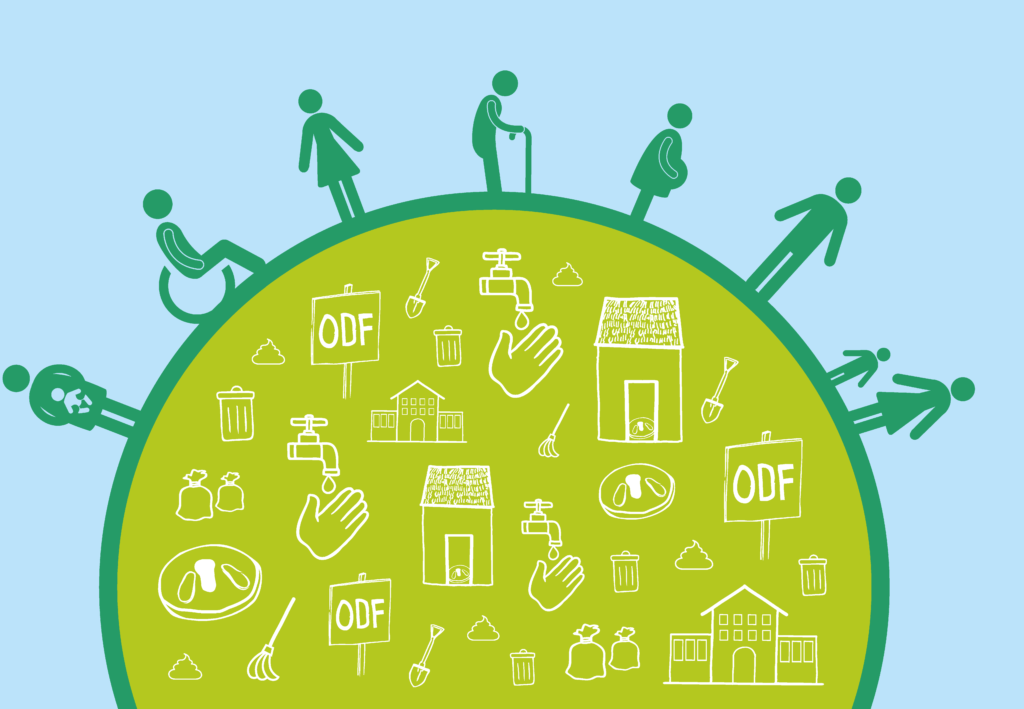Our 2015 chapter, “Community-Led Total Sanitation (CLTS) and sanitation marketing: aspects to consider for a better integrated approach”, explored emerging lessons from the integration of CLTS and sanitation marketing (SanMark) in three large programmes in Zambia, Tanzania and Malawi. In this present blog, I reflect on the evidence from the last seven years in Zambia to:
- Identify what worked and did not
- Itemise adjustments made and what needs further investigation.
To support integration, the original chapter modelled eight aspects: phasing, affordability, financing, supply chains, masons and entrepreneurs, informed choice, technology and monitoring.
Supply chains
Supply chains refer to the organisation of the supply-side to support product development, delivery and deployment. Prior to SanMark interventions, SNV in partnership with local councils carried out:
- a sanitation supply chain study to understand the technologies available, actors, regulations and market gaps and,
- a consumer demand study to profile clients, existing financing options and their willingness to pay.
The supply chain study found that:
- There were only a few hardware suppliers available at district level,
- At the community level, most latrine options were Do It Yourself (DIY), and
- that only a few bricklayers traded their services for cash or a barter system.
- Hygiene markets were underdeveloped and had only one product; the DIY tippy taps.
- Technology innovation for the DIY latrines was often confined to changing from rectangular to round pit holes and slab holes (which take longer to collapse), or building on old anthills for durability.
Community income levels were low and there was a lack of financing options to support access to sanitation options for consumers. It also highlighted the technology needs of different groups, i.e., the elderly and the disabled, consumers in waterlogged areas.
This evidence was used to systematically formulate the following SanMark strategies:
Informed Choice:
To support options for consumer choice, leaflets for local longer-lasting latrine technologies were included in CLTS triggering.
Technologies
An independent prognostic study in Zambia showed that the low quality of latrines built after CLTS increased the likelihood of communities reverting back to open defecation. Using this evidence, market support included a pilot test of the SAFI latrine technology for consumer and market acceptability via demonstration centres. Feedback from consumers and masons was used to modify the technology, including a raised pour flush option amongst other contextualisation. Once stakeholders were satisfied, the SAFI rollout was initiated. The slab and initial lining for the SAFI ranged between $70-120, two to three times the cost of the common latrine technology option. Additionally, the markets innovated to include the ‘kokola’ handwashing station which cost $7, as a top end hygiene facility alternative to the tippy tap.
Moulds used for the slabs were initially produced in partnership with a government skills and trades school. However, this process had substantial red-tape, which delayed market launch and scaling. The process competed with time and the infrastructure used for student learning Furthermore, the institution utilised students due to limited staff due to long procurement processes, retaining minimal institutional technical capacity.
To address this issue, the production of moulds was moved to a local supplier who used master masons and was also a distributor of the key materials for the SAFI latrine: cement, wire mesh and iron rods. The moulds were then provided as seed capital to masons.
Masons and entrepreneurs
Skilled bricklayers within wards (sub-district structures) were trained as masons for the new array of SAFI latrine technology, supported by the Ministry of Community Development and Social Welfare. Two Ministry lecturers and two masons from each district were identified as technical leads and master masons. They conducted in-district training for ward masons to support rollout. However, after just six months, the attrition rate for masons was as high as 60% for a few reasons:
- Difficult transportation of the heavy construction moulds within wards.
- Low profit margins for sanitation construction compared to houses and other structures.
- Difficulties working with CLTS champions who were already established and did not fully include masons in their post-triggering, leaving them out of meetings, meaning the masons had to break their own new marketing ground to win customers.
To address these challenges, SNV used:
- Sanitation Marketing Committees – consisting of 8 members within each ward, including a mason, a CLTS champion, marketeers, savings group leader and other actors. The mason was no longer the head of the sanitation business but a commission-earning contractor for SanMark. The committee integrated social marketing approaches and used their own networks to sell the SAFI latrines and the kokola handwashing station. As formal business entities they could successfully bid for toilet contraction tenders at schools, marketplaces, and clinics.
- Onsite mason training – to reduce costs and enhance local capacity and technical networking of committees, where attrition had occurred.
- Theatre for transformation – a roadshow using drama, music, comedy and dance where consumers registered with SanMark committees and paid upfront, using barter or cash for latrine construction. This created demand beyond triggering with over 1000 SAFI latrines and 1600 kokola handwashing purchased in 20 roadshows.
- Use of large marketing centres to source materials: Most committees are in communities far away from district centres stocking the necessary production components for the SAFI latrines and kokola handwashing facilities. The major district supplier innovatively ‘unbundled’ their products and sold them in small quantities using the ‘Munada’, a large mobile market bringing sellers from the district level and beyond, to sub-district areas. However, SanMark had to factor in the lead-in time for the unique products and sporadic nature of the Munada, which then slowed down sales, stifling demand and production. Thus, SanMark ended up depending on unsustainable and intermittent project and government transportation. Better approaches for the local delivery of materials are needed.
Financing
The government, through the local district councils, considered several financing options, including engaging a local bank to provide loans as well as postal services offering credit. However, this required large initial seed capital to reduce risk of default and additional administrative costs. After a year of attempting to set this up, the following adjustments were used:
Barter system: SanMark committees allowed different means of payment including barter, where prices were calculated in chickens, maize grains and goats. In this way, SanMark would sell their items at the district centres or large markets. SNV and the district councils did not investigate, however, whether these alternative financing options have created additional costs for committees.
Seed capital: SNV and the district councils supported the SanMark committees’ seed capital for construction moulds, as well as initial inputs for SAFI latrine construction and local demonstration sites. The committees also created a savings scheme where households saved and, once a threshold was achieved, received an upfront Kokola handwash facility or construction of the SAFI latrine. The savings component also ensured that the SanMark committees met regularly for their planning.
One major supplier in Mungwi provided loans to committees. Each loan allowed for the construction of 20 SAFI latrines across 16 wards. The initial rollout was efficient and committees were able to raise funds from sales and pay back the loans. However, over time, there was a lot of defaulting from committees due to low sales and attrition. Furthermore, as the loan contracts were signed with the coordinating district committee and not the actual supplier, SanMark perceived the loans as a continuation of seed capital grant support. Therefore, the loans initiative was abandoned. The supplier incurred losses and the relationship between the supplier and the committees was strained. This example shows the need to exercise caution when introducing market-based financing options in the presence of project grants.
Monitoring
The district health information management systems (HIMS) which provide indicators for tracking CLTS do not track sanitation marketing. SNV and the district councils supported the committees with a mobile phone and web connectivity for tracking sales, stock and financing. However, unreliable internet access prevented regular system updates along with other technological challenges and the tool was abandoned. It is clear that support needs to be focused on long term assistance to government to include SanMark indicators in their HIMS.
Phasing
Evidence from Zambia showed that effective and responsive markets need to be developed over time long before CLTS is introduced. Before CLTS, there is a need for:
- programming to understand the market,
- testing context specific technologies,
- training supply chain actors,
- developing mechanisms for financing, and
- improving supply chains for materials.
CLTS triggering alone is not enough to steer demand for top end market-based sanitation options.
The implementation of the SNV SSH4A project highlighted necessary alternatives such as theatre for transformation which create local demand. In fact, the traditional CLTS approach demands the use of locally available materials to support sanitation and hygiene needs of triggered communities. But this blog has shown, sanitation marketing introduces innovations that might not necessarily be local and would conceptually go against the CLTS principles if introduced after triggering. Thus, market development should happen earlier than CLTS triggering for people to accept the external solutions, which then attain a kind of ‘secondary local’ status. In the Zambia experience, sanitation marketing can take a minimum of 2.5 years to develop.
Conclusions
The blog has highlighted several lessons learned in phasing SanMark and CLTS:
- The supply chain and demand sides must be developed prior to CLTS programming.
- Programmes must train masons together with other local actors, to increase local marketing networking, reduce attrition, and strengthening accountability.
- External sanitation and hygiene options can be introduced into local contexts as options for sanitation markets
- Local options for financing sanitation such as community savings, can be more impactful than commercial alternatives.
About the author: Warren Mukelabai Simangolwa is the founder of the Patient and Citizen Involvement in Health, an organization that helps the most disadvantaged people gain sustained access to health and social care. A health economist, Warren has worked and consulted extensively in Sub-Saharan Africa on health financing, market access for global public goods, health technology assessments, and public and social policy.







